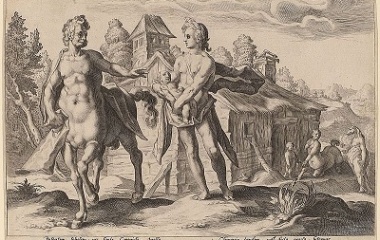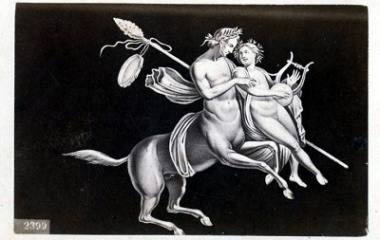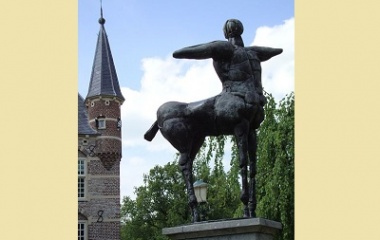Who is Chiron?
Chiron is a wise and noble-hearted centaur, often given charge of the young heroes of Greek mythology. With his many talents and his gentle nature, he can train the heroes in everything from the deadly arts of hunting and archery to the delicate arts of music and healing.
Characteristics
Physical Description
Chiron is described as a centaur, a creature with a man’s head and torso melting into the powerful body of a horse. However, the nobility of his spirit easily eclipses his fellow centaurs, and his appearance bears telltale signs of his superiority.
Unlike other centaurs, who have four horse legs, Chiron’s forelegs are human and hind-legs are horse. His face is an image of strength and classical beauty, lacking the pointed ears and wild hair that give other centaurs a roguish look, and he frequently wears clothes, even laurel wreaths, which show how civilized he is in comparison to his brethren.
Personality
Of all the characters in Greek mythology, Chiron has perhaps the most pure and selfless heart. You’ll never find him involved in the tricks or squabbles of the other immortals; his dignity holds him above their schemes.
First and foremost, this magnificent centaur has a teacher’s heart. He is incredibly intelligent and far-sighted, yet he is also humble and nurturing. This rare combination makes him a highly sought-after instructor—but he welcomes everyone into his home, no matter how weak or lowly they might seem. Everyone who leaves his home, after living under his care and guidance, is stronger and wiser than they were when they arrived.
Second, he is brave and self-sacrificing. He risks his life for his friends and students on multiple occasions, and ultimately, he chooses to sacrifice his immortality to save someone else’s life.
Special Abilities
Chiron is a talented archer, hunter, musician, oracle, and healer. His skill with a bow and arrow is unsurpassable, although his student Achilles became sporting rivals. His favorite instrument is the lyre, which he plays flawlessly, even by Apollo’s standards. As an oracle, he has knowledge of hidden secrets and future events, which he demonstrated when he told Peleus how to make the ravishingly beautiful sea nymph, Thetis, his wife.
Still, the mighty centaur’s most prolific talent is his healing ability. He knows all the herbs that grow in the pristine woodlands of his home on Mount Pelion, and he can use them to great effect. He has healed many deep wounds for his students, but his most famous accomplishment was restoring sight to Phoenix, a hero who had gone blind.
Related Creatures
Chiron’s lineage is different from the other centaurs, which may explain some of the differences between them. His father was Cronus, one of the original titans who ruled before the gods, and his mother was Philyra, a beautiful ocean nymph. Unfortunately, Cronus and Philyra were caught in the middle of their tryst by Rhea, Cronus’ wife. Disgraced, the Titan turned himself into a stallion and galloped away. Months later, when Philyra gave birth to their son, the baby’s form was half horse. Philyra was revolted by her child’s monstrous form; she abandoned him and begged the gods to transform her into another form, so that she could forget her disgrace. The gods turned her into a Linden tree.
Poor Chiron was effectively orphaned, but luck quickly turned in his favor. The radiant god Apollo found the baby and decided to take him in as his own son. He taught the orphan how to repress his animal urges and live nobly, in a way that would highlight his humanity, even his divinity. Apollo also taught the young centaur about music and medicine. Apollo’s twin sister, Artemis, approved of his project and decided to come aboard as the orphan’s foster mother. She taught him about archery and hunting.
After he grew up, the orphan made his foster parents proud by becoming a revered teacher. He was always eager to return the kindness that Apollo and Artemis had shown him, and he took on many young students of his own, including Achilles, Ajax, Heracles, Jason, Peleus, Perseus, and Theseus.
In addition to his students, the centaur had biological children of his own. He was married to a nymph named Chariclo, and with her he had three daughters, Melanippe, Endeis, and Ocyrhoe, and one son, Carystus.
Cultural Representation
Origin
Chiron appears in the epic poems of ancient Greek writers, including Ovid, Pindar, Homer, and Hesiod, which date all the way back to the 7th or 8th century AD.
Still, some scholars believe that this unusual centaur might have had a pre-Greek origin, which could explain some of the peculiarities that separate him from traditional Greek centaurs. He may have been a god from Thessaly, the nation that surrounded Chiron’s legendary home, Mount Pelion, before it was conquered by the Greeks.
Famous Myths
Chiron’s life is well documented by Greek poets and scholars. There are stories from each chapter of his life, from his unlikely conception and birth to his heartrending death.
The centaur’s relationship with Peleus, a Greek king and hero, winds a long thread through his fabled life. Their story began when Peleus and his friend, Acastus, went hunting in the wilderness. Unknown to Peleus, he was travelling with a traitor; Acastus was plotting against Peleus’ life because his wife had fallen in love with the new hero. The two friends laid down in the brush to take a nap, but when Peleus awoke, both Acastus and his sword were missing. Peleus was left helpless and would have died if Chiron had not found his sword, returned it to him, and cared for him until he returned home. Later, Peleus returned to consult the centaur, whom he considered a kind friend, about a new problem: he was desperately in love with an ocean nymph, Thetis, but he didn’t know how to win her as his wife. Chiron told him where he could find the nymph and how he could win her for a bride, and with the centaur’s guidance, he was successful. The couple even held their wedding, a sumptuous event which was attended by many of the gods, in Chiron’s cave on Mount Pelion. Later, Peleus sent his and Thetis’ only son, Achilles, to be taught by the centaur.
Another important relationship in Chiron’s life was with his daughter, Melanippe. Among all his daughters, Melanippe was the most beautiful and the most gifted. She was deeply prophetic, and she liked to predict the fates of the young heroes who passed through her father’s cave. She even foretold her own father’s death, although the vision caused her enormous grief (according to some legends, she grieved so much that she died and became an image in the stars). Intelligent though she was, Melanippe was unable to resist Aeolus, grandson of Zeus and son of Greek’s most legendary beauty, Helen, when he came into the wilderness to woo her. Soon, she was pregnant with Aeolus’ child, and she ran away from home to conceal the pregnancy from her father, who had raised all his daughters as virgins devoted to Artemis. Chiron went looking for his daughter, and she begged the gods to hide her in any way. Thus, they transformed her into a black mare so she could give birth. After giving birth, she passed into the stars.
The story which brought Chiron’s wonderful life to an end shows the final height of his kindheartedness. Yet another Greek hero, Heracles, was visiting his cave, and the two adventurers began to examine Heracles’ weapons. Heracles was eager to show off a set of arrows, poisoned with venom from the monstrous hydra, which he had recently killed. By a freak accident (some myths say that Chiron dropped one of arrows, others that Heracles accidently released it when he was testing his bow), Chiron was pierced by one of the poison arrows. The wound didn’t kill him because he was immortal, but it caused him terrible, debilitating pain. Remarkably, the wounded centaur wasn’t angry with Heracles. Instead, he tried to comfort the young hero, who was horrified by what he had done to such a great teacher. After days of suffering, the centaur came up with a plan that would relieve his pain and Heracles guilt; he volunteered to help Heracles accomplish his final great task, freeing Prometheus, which required an immortal life to be sacrificed for Prometheus’s sake. Thus, the wise and gentle teacher, who had trained so many of Greece’s heroes, died, and Heracles was able to free Prometheus. As a token of their admiration for this final heroic act, the gods placed the centaur in the sky as a constellation.
Visual Arts
Early Greek pottery is rife with imagery of Chiron and his students, especially Achilles. In these early images, the noble teacher appears just as he does in the epic poems; he has a human body, complete with two human legs, and a horse’s hindquarters are attached to his waist. In later Greek artwork, he has begun to appear more centaur-like, having all four horse legs, and by the time he was adopted by the Romans, he had permanently lost his human legs—although he still wore cloaks and laurel to symbolize his nobility.











Beautifully written!